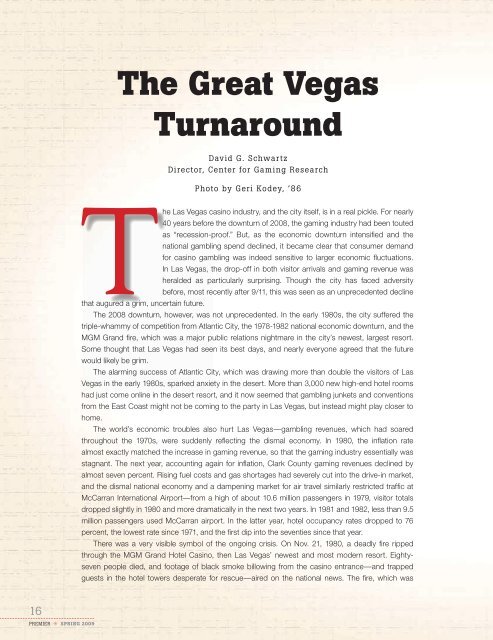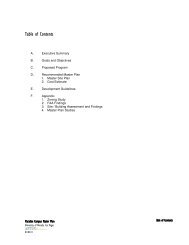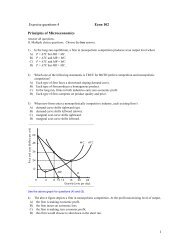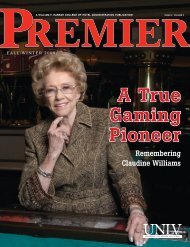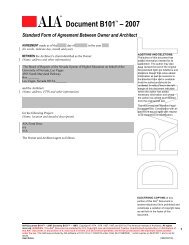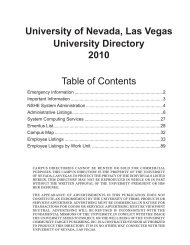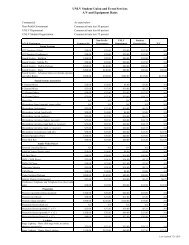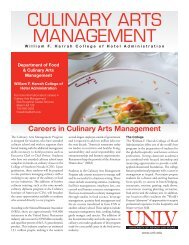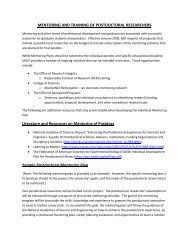Download - University of Nevada, Las Vegas
Download - University of Nevada, Las Vegas
Download - University of Nevada, Las Vegas
You also want an ePaper? Increase the reach of your titles
YUMPU automatically turns print PDFs into web optimized ePapers that Google loves.
The Great <strong>Vegas</strong><br />
Turnaround<br />
Photo by Geri Kodey, ’86<br />
The <strong>Las</strong> <strong>Vegas</strong> casino industry, and the city itself, is in a real pickle. For nearly<br />
40 years before the downturn <strong>of</strong> 2008, the gaming industry had been touted<br />
as “recession-pro<strong>of</strong>.” But, as the economic downturn intensified and the<br />
national gambling spend declined, it became clear that consumer demand<br />
for casino gambling was indeed sensitive to larger economic fluctuations.<br />
In <strong>Las</strong> <strong>Vegas</strong>, the drop-<strong>of</strong>f in both visitor arrivals and gaming revenue was<br />
heralded as particularly surprising. Though the city has faced adversity<br />
before, most recently after 9/11, this was seen as an unprecedented decline<br />
that augured a grim, uncertain future.<br />
The 2008 downturn, however, was not unprecedented. In the early 1980s, the city suffered the<br />
triple-whammy <strong>of</strong> competition from Atlantic City, the 1978-1982 national economic downturn, and the<br />
MGM Grand fire, which was a major public relations nightmare in the city’s newest, largest resort.<br />
Some thought that <strong>Las</strong> <strong>Vegas</strong> had seen its best days, and nearly everyone agreed that the future<br />
would likely be grim.<br />
The alarming success <strong>of</strong> Atlantic City, which was drawing more than double the visitors <strong>of</strong> <strong>Las</strong><br />
<strong>Vegas</strong> in the early 1980s, sparked anxiety in the desert. More than 3,000 new high-end hotel rooms<br />
had just come online in the desert resort, and it now seemed that gambling junkets and conventions<br />
from the East Coast might not be coming to the party in <strong>Las</strong> <strong>Vegas</strong>, but instead might play closer to<br />
home.<br />
Dav id G. Schwar tz<br />
Director, Center for Gaming Research<br />
The world’s economic troubles also hurt <strong>Las</strong> <strong>Vegas</strong>—gambling revenues, which had soared<br />
throughout the 1970s, were suddenly reflecting the dismal economy. In 1980, the inflation rate<br />
almost exactly matched the increase in gaming revenue, so that the gaming industry essentially was<br />
stagnant. The next year, accounting again for inflation, Clark County gaming revenues declined by<br />
almost seven percent. Rising fuel costs and gas shortages had severely cut into the drive-in market,<br />
and the dismal national economy and a dampening market for air travel similarly restricted traffic at<br />
McCarran International Airport—from a high <strong>of</strong> about 10.6 million passengers in 1979, visitor totals<br />
dropped slightly in 1980 and more dramatically in the next two years. In 1981 and 1982, less than 9.5<br />
million passengers used McCarran airport. In the latter year, hotel occupancy rates dropped to 76<br />
percent, the lowest rate since 1971, and the first dip into the seventies since that year.<br />
There was a very visible symbol <strong>of</strong> the ongoing crisis. On Nov. 21, 1980, a deadly fire ripped<br />
through the MGM Grand Hotel Casino, then <strong>Las</strong> <strong>Vegas</strong>’ newest and most modern resort. Eightyseven<br />
people died, and footage <strong>of</strong> black smoke billowing from the casino entrance—and trapped<br />
guests in the hotel towers desperate for rescue—aired on the national news. The fire, which was<br />
16<br />
PREMIER ≤ SPRING 2009


